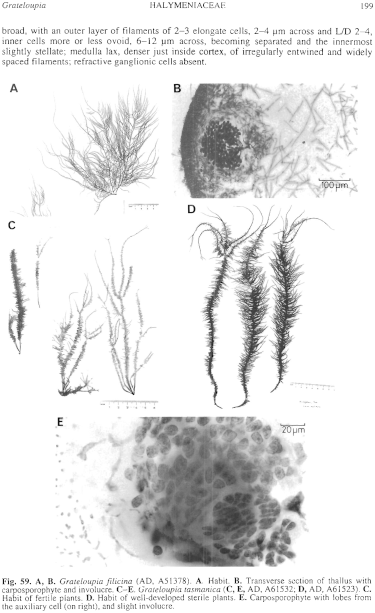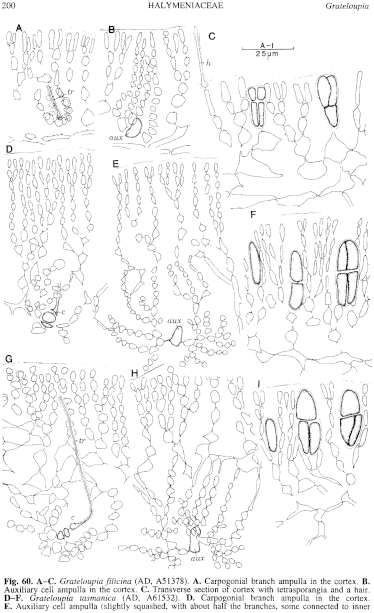|
|
|
|
|
|||||||||||
|
Electronic Flora of South Australia Species Fact Sheet
Phylum Rhodophyta – Class Florideophyceae – Order Gigartinales – Family Halymeniaceae
Selected citations: Kylin 1930: 19, figs 9–11.
Synonym
var. luxurians Gepp & Gepp 1906: 259. Farnham 1980: 892. Irvine 1983: 27, fig. 7B, C. Millar & Kraft 1993: 18.
Thallus (Fig. 59A) yellow-brown to dark red-brown, 10–25 cm high, soft and mucilaginous (adhering strongly to paper), becoming cartilaginous (and less adherent to paper) when old, largely complanately branched, bi- to tri-pinnate, with closely set laterals and occasional proliferous branchlets on the surfaces of axes; axes compressed, (1–) 2–3 (–5) mm broad centrally, narrower near the holdfast and tapering above; main laterals 5–15 cm long, 1–2 (–3) mm broad and ovate in section, closely set with alternate to irregular distichous ramuli 2–15 (–25) mm long and 0.2–1 mm broad. Holdfast discoid, 0.4–2 (–3) mm across, with one to several fronds; epilithic. Structure (Fig. 59B) of a cortex 5–8 cells broad, with an outer layer of filaments of 2–3 elongate cells, 2–4 µm across and L/D 2–4, inner cells more or less ovoid, 6–12 µm across, becoming separated and the innermost slightly stellate; medulla lax, denser just inside cortex, of irregularly entwined and widely spaced filaments; refractive ganglionic cells absent.
Reproduction: Sexual thalli dioecious. Carpogonial branch ampullae (Fig. 60A) arising in the inner cortex, with 2–3 secondary filaments and a 2-celled carpogonial branch. Auxiliary cell ampullae (Fig. 60B) in the inner cortex, with 3–4 secondary filaments, converging above and reaching to the surface, and a moderately prominent auxiliary cell. Carposporophyte (Fig. 59B) 120–160 µm across, with a small basal fusion cell giving rise to sterile filaments bearing ovoid carposporangia 10–18 µm across; involucre prominent, derived largely from medullary filaments, ostiole present. Spermatangia cut off from outer cortical cells.
Tetrasporangia (Fig. 60C) on mid cortical cells, scattered, elongate-ovoid to clavate, 25–36 µm long and 8–15 µm in diameter, cruciately divided.
Type (of var. luxurians) from Farm Cove, Sydney, N.S.W. (Lucas 6, July 1901); holotype in BM. The type of var. filicina was from the Adriatic, lectotypified by the original illustration of Wulfen (1789, pl. 15 fig. 2) - see Dixon 1959, p. 349.
Selected specimens: Cottesloe, W. Aust., on reef (Smith, April 1945; AD, A2139). Middleton Beach, Albany, W. Aust., low eulittoral (Womersley, 29.viii.1979; AD, A51378 -"Marine Algae of southern Australia" No. 202). Outer Harbor, S. Aust., low eulittoral (Womersley, 16.vii.1950; AD, A13286). Port Stanvac, S. Aust., 1 m deep on jetty pylons (R. Lewis, 2.x.1972; AD, A49109). Portarlington, Vic., just below low tide level (Sinkora A1475, 29.xi.1971; AD, A43175). Williamstown, Vic., 1–2 m deep (J. Lewis, 6.iii.1975; MELU, A21956). San Remo, Vic., at low tide level (Womersley, 16.ii.1990; AD, A60295). Ulverstone, Tas., drift (Gordon & Bowen, 18.i.1966; AD, A29977). Low Head, Tas., at low tide (Perrin, 20.viii.1947; AD, A8470). Dover, Tas., upper sublittoral (Wollaston & Mitchell, 27.ii.1964; AD, A27725). Pittwater, N.S.W., drift (Harada, 21.x.1975; AD, A52495). Wybury Head, Qld (Harada, 22.vii.1975; NSW, 7824).
Distribution: Southern England, Mediterranean, Africa, Caribbean, Indo-Pacific. Cottesloe, W. Aust., to Wybury Head, Qld, and around Tasmania.
Taxonomic notes: All southern Australian specimens are to be placed under var. luxurians Gepp & Gepp, differing from the European type variety in their greater size. They are confined largely to the vicinity of harbours and sheltered coasts, where they can occur in abundance in shallow water or just above low tide level.
References:
AGARDH, C.A. (1822). Species Algarum. Vol. 1, Part 2, pp. 169–398. (Berling: Lund.)
DIXON, P.S. (1959). Taxonomic and nomenclatural notes on the Florideae, I. Bot. Notiser 112, 339–352.
FARNHAM, W.F. (1980). Studies on Aliens in the Marine Flora of southern England. In Price, J.H., Irvine, D.E.G. & Farnham, W.F. (Eds), The Shore Environment, Vol. 2, pp. 875–914. Syst. Assn Special Vol. 17b. (Academic Press: London.)
GEPP, A. & GEPP, E.S. (1906). Some marine algae from New South Wales. J. Bot., Lond. 1906, 249–261, Plate 481.
IRVINE, L.M. (1983). Seaweeds of the British Isles. Volume I. Rhodophyta. Part 2A, Cryptonemiales (sensu stricto), Palmariales, Rhodymeniales. [British Museum (N.H.): London.]
KYLIN, H. (1930). über die entwicklungsgeschichte der Florideen. Lunds Univ. Årsskr. N.F. Avd. 2, 26 (6), 1–104.
MILLAR, A.J.K. & KRAFT, G.T. (1993). Catalogue of Marine and Freshwater Red Algae (Rhodophyta) of New South Wales, including Lord Howe Island, South-western Pacific. Aust. Syst. Bot. 6, 1–90.
WULFEN, F.X. (1789). Plantae rariores Carinthiacae. In Jacquin, N.J., Collectanea ad botanicam, chemiam et historiam naturalem .... Vol. 3, pp. 3–166. (Vienna.)
The Marine Benthic Flora of Southern Australia Part IIIA complete list of references.
Publication:
Womersley, H.B.S. (14 January, 1994)
The Marine Benthic Flora of Southern Australia
Rhodophyta. Part IIIA, Bangiophyceae and Florideophyceae (to Gigartinales)
Reproduced with permission from The Marine Benthic Flora of Southern Australia Part IIIA 1994, by H.B.S. Womersley. Australian Biological Resources Study, Canberra. Copyright Commonwealth of Australia.
Illustrations in Womersley Part IIIA, 1994: FIGS 59A, B, 60 A–C.

Figure 59 enlarge
Fig. 59. A, B. Grateloupia filicina (AD, A51378). A. Habit. B. Transverse section of thallus with carposporophyte and involucre. C–E. Grateloupia tasmanica (C, E, AD, A61532; D, AD, A61523). C. Habit of fertile plants. D. Habit of well-developed sterile plants. E. Carposporophyte with lobes from the auxiliary cell (on right), and slight involucre.

Figure 60 enlarge
Fig. 60. A–C. Grateloupia filicina (AD, A51378). A. Carpogonial branch ampulla in the cortex. B. Auxiliary cell ampulla in the cortex. C. Transverse section of cortex with tetrasporangia and a hair. D–F. Grateloupia tasmanica (AD, A61532). D. Carpogonial branch ampulla in the cortex. E. Auxiliary cell ampulla (slightly squashed, with about half the branches, some connected to inner cortical cells). F. Transverse section of cortex with tetrasporangia. G–I. Grateloupia intestinalis (AD, A61524). G. Carpogonial branch ampulla in the cortex. H. Auxiliary cell ampulla, with filaments connected to inner cortical cells. I. Transverse section of cortex with tetrasporangia.

|
Email Contact: State Herbarium of South Australia |

|